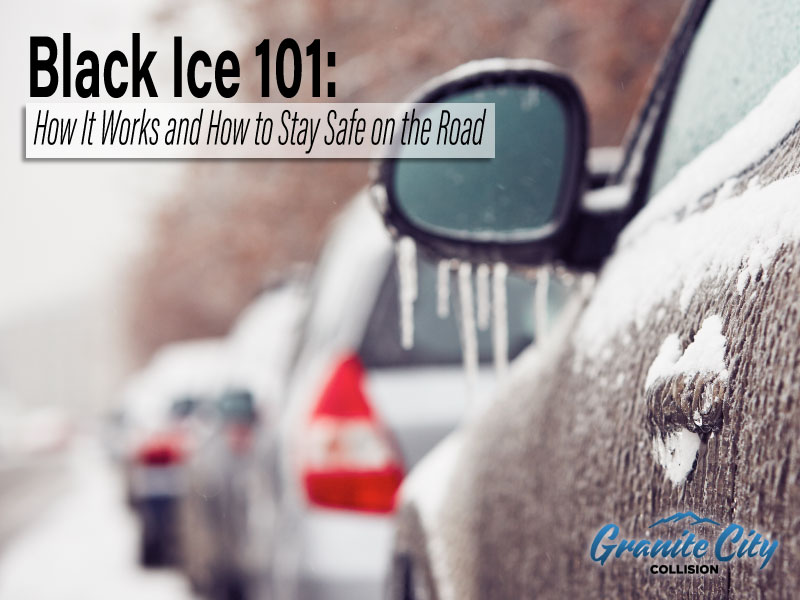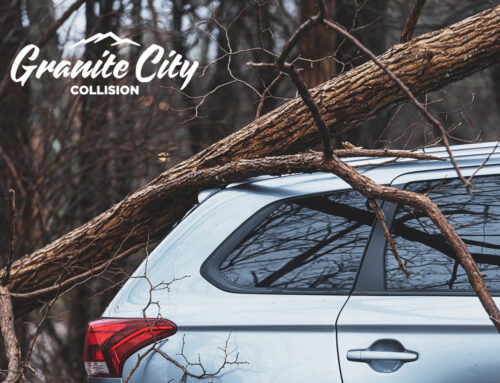Winter often brings with it the beautiful scenery of powdery snow and lustrous ice. It can make for cozy, movie-like moments and create a sense that time has stopped (or at least slowed) for a moment—a feeling welcomed by many kids and adults alike as their daily routines are put on hold.
But winter also comes with dangerous driving conditions. It’s rather obvious when roads are covered in snow or white ice. Depending on where you live, many schools and workplaces may even shut down if there is any sign of wintery road conditions in your area. However, there is one kind of road hazard that is particularly dangerous and often difficult to spot until late in the morning or afternoon: black ice.
In fact, black ice is flat-out treacherous. It can be virtually impossible to distinguish from normal rain, melted snow, or a puddle of water. And if you drive or walk across it unprepared, it can instantly cause you to slip or lose control of your vehicle, putting you in a desperate situation.
That’s why it’s critical to learn as much as you can about black ice. By knowing what it is, how it forms, where it most often occurs, how to identify it, and what precautions you can take, you will put yourself and others in a safer position during the colder months. Below, we’ve provided some practical information and advice on how you can best prepare for black ice and other types of hazardous weather this winter.
WHAT IS BLACK ICE?
Black ice is known for its deceiving nature. Yes, driving in winter is already difficult. And when black ice is added to the picture, it goes to a whole new level. In the most basic sense, black ice is a thin layer of ice that forms on a road or walkway.
Unlike white ice, which is relatively easy to see because of bubbles and swirls that are trapped in the ice, black ice is thin enough for asphalt and blacktop to be seen through it. It’s perfectly clear, which is where the name “black ice” comes from. This is also why black ice is so hard to see, particularly on dark nights and sunless mornings. Thus, it’s clear how this substance can so treacherous as you’re trying to navigate already-difficult driving conditions.
HOW BLACK ICE FORMS
So, how does this translucent, uber-hazardous substance come to be? It hinges on two conditions.
For one, there must be water that falls gently onto the road or walking surface, whether it’s misty rain, fog, residual snow, or exhaust condensation from vehicles. Why must the water fall gently? Because splashing or pounding rain would cause occlusions (bubbles and swirls) to form, which would form white ice. The other requirement for black ice to form is that it cannot be windy. This is because the wind would create occlusions in the ice, which would render it white ice.
It’s worth noting that black ice can form on sunny days, so long as the temperatures are below freezing. As the sun warms the road surface, it melts the snow, ice, or slush that remains on the road. The melted water can then refreeze overnight, creating a slick sheet of black ice.
Also, the air temperature doesn’t have to be 32 degrees Fahrenheit (0 degrees Celsius) or lower in order for black ice to occur. Black ice is frequently so thin that it can form in slightly warmer temperatures, as long as the road surface is at or below freezing. In most cases, this happens during the early morning hours, before the sun has warmed up the pavement. Consequently, this is also the time that many people are still waking up and rushing to work, which can make for a dangerous recipe.
HABITATS FOR BLACK ICE
While it’s often very difficult to spot black ice, knowing where it tends to occur can be helpful. You may already know whether or not you get it in your area. For example, North Carolina residents are far more likely to run into black ice than people who live in Florida. However, it’s essential to know where to look for it so that you can practice extra caution.
For starters, black ice often forms on bridges and highway overpasses, which is why you see so many road signs warning you of these surfaces freezing. Most of the time, the freezing water on a bridge or overpass is black ice. The primary reason for this is that bridges and overpasses are not resting on the ground, which means they are not insulated against the cold air and wind swirling around them. This leaves these structures vulnerable to drastic changes in temperature; thus, the tiniest amount of water on a bridge or overpass can quickly turn into black ice.
Shaded and sunless areas are also susceptible to black ice. If you live in a crowded city, be cautious when accessing underpasses and tunnels, as exhaust condensation from vehicles traveling the night before can leave just enough water to freeze into a nice, thin sheet of treacherous ice. If you live in a more rural area, pay careful attention to any spots where tree branches extend over the road and block the sun.
Also, if you live in the country, you should be wary of traveling on back roads that don’t see many cars. Unlike in the city, where steady traffic warms up the roads, back roads in rural areas don’t experience as much traffic. This means that ice is more likely to stick around for longer.
HOW TO RECOGNIZE BLACK ICE
As we’ve already discussed, it can be very difficult to actually see black ice while you’re driving. In many cases, it simply isn’t possible. That said, sometimes black ice will show itself; if you notice that the roadway is darker in some spots and lighter in others, it could be an indicator that black ice is present.
Since you often cannot detect black ice, it’s always safest to drive with caution all throughout winter, especially on and around bridges and overpasses, as well as areas of the road that don’t receive much sunlight. This holds true whether or not it has precipitated within the past few days. Furthermore, remember that black ice is most likely to form between sunset and sunrise. And if it stays cloudy for days on end, it can stick around until temperatures rise enough to melt and dry it.
PROTECTING YOURSELF FROM BLACK ICE
We’ve established that black ice is dangerous and hard to identify. You know to always be on the lookout while on the road during winter. Now, let’s discuss some other ways that you can protect yourself and others from a black-ice-induced accident:
Stay home
First of all, if at all possible, stay at home when harsh winter weather abounds. This is by far the most effective way of avoiding the dangers of black ice and other hazardous road conditions. However, sometimes it’s not practical. Maybe you need to get to work, go to the grocery store, or fulfill some other daily task. Just use your best judgment during winter, especially when you know the roads could be treacherous.
Keep up with the local forecasts
Each day in winter, it’s essential to stay up to date on the local forecast. This will keep you informed of when the temperatures are hovering around freezing and precipitation is on the way. In some cases, you may even hear about specific locations in your area where black ice has been spotted.
Check your tires
Your tires are the only part of the vehicle that touches the road. And when the tread is worn out or a tire is compromised in some other way—such as being cracked or having sidewall bulges—grip will be compromised along with your safety. Take your vehicle in to get the tires checked, and replace them if necessary. Also, consider getting snow tires if your area experiences excessive winter weather.
Make sure you can see
Before leaving your driveway each morning, be sure to warm your vehicle up for a few minutes with the defrost on. Then, clear any snow and ice off of the windshield and windows. The last thing you want is to be going down the road with limited visibility during winter.
Don’t hurry
In the colder months, it’s important to leave a little extra time for any trip you’re taking, even if you’re just going down the street. This is because you’ll want to drive slower and allow for traffic and unexpected stops. Also, make sure you leave plenty of space between you and other vehicles, especially in slippery conditions; that way, you’ll be better able to react to sudden changes in traffic.
Be content in the slow lane
One thing you don’t want to do in poor driving conditions is to weave in and out of lanes. Choose a lane, ideally the slow lane, and stick with it. If other vehicles on the road want to go faster, let them pass you. That way, you can drive at a safe pace and decrease the likelihood of causing an accident.
Pay attention to tire spray
Another thing you can do is pay attention to the tires of the vehicle in front of you, as well as those passing by. If there is a bunch of water spraying off the tires, it means that the road is still wet. If there isn’t, it could mean the water on the roadway is freezing.
Stay straight
Along with avoiding frequent lane changes, be extra careful when driving around bends and turning down streets. The less you have to turn your steering wheel, the better. This is because drastic or sudden turns of the wheel are even more dangerous in poor weather than in normal conditions. Stay as straight as possible, and slow down ahead of time to allow yourself plenty of space for turns.
Ease off the brakes
When slowing down, try to avoid braking as much as you can. If you realize that you’re going too fast, simply take your foot off the accelerator instead of applying the brakes. Slowing down naturally is much safer in winter driving conditions. Similarly, be easy on the gas, as accelerating too quickly can also put you and other vehicles in harm’s way.
Opt out of cruise control
Using cruise control can help you avoid speeding tickets and even keep you safer in certain situations. But in poor driving conditions, it can significantly compromise your safety. That’s because, when you’re driving on snow or ice, you want to remain completely in control of your vehicle at all times. And if your cruise control automatically accelerates your vehicle, it can cause all kinds of problems. Therefore, save your cruise control function for dry pavement only.
Conclusion
Black ice is nothing to play around with. By understanding how black ice works and knowing when and where to look for it, you can better prepare for safe driving during winter. Remember to follow the safe driving tips above, particularly when temperatures are below freezing. Though we specialize in repairing damaged vehicles here at Granite City Collision, we want you to take every precaution necessary to prevent any dangerous accidents on the road!






